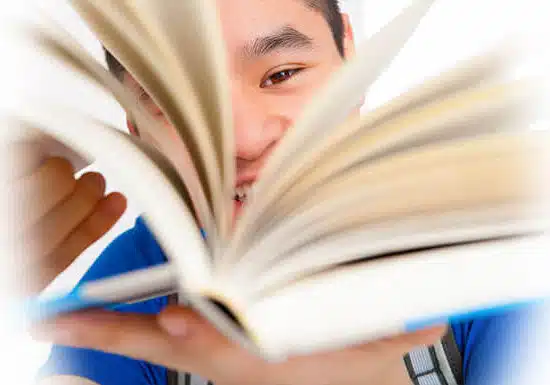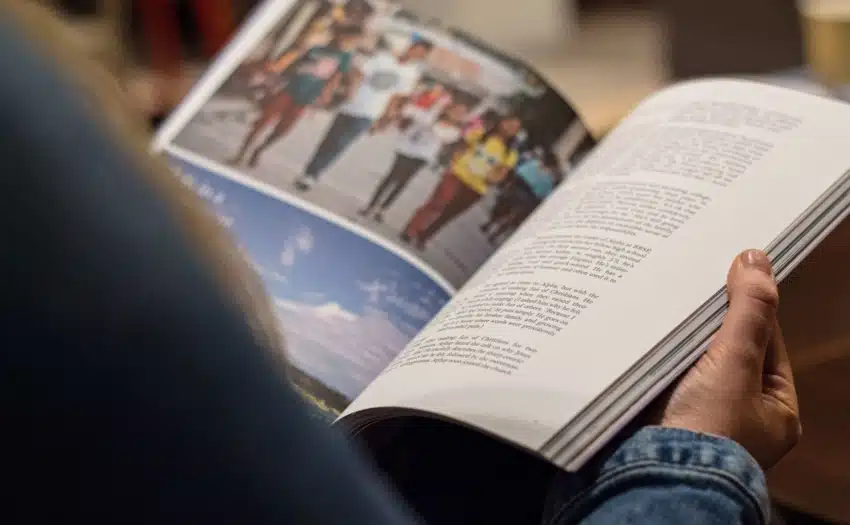Reading Techniques – Enhance Your Academic Skills
Updated: October 13, 2025

As a student, you read a lot, and not all texts need the same approach. The right technique helps you understand faster, remember more, and study with less stress.
In this guide, you will learn practical methods like SQ3R, skimming, scanning, active reading, detailed reading, and structure-proposition-evaluation, plus simple tips to set a purpose and adjust your speed.
Key Takeaways
- Multiple reading techniques are available: Depending on your goal and the type of text, you can choose from SQ3R, skimming, scanning, active reading, detailed reading, and structure-proposition-evaluation.
- Active engagement is essential: Ask questions as you read, take notes, and keep a global understanding of the text instead of passively moving your eyes across the page.
- Flexible reading speed strategy: Speed up for familiar or repetitive material and slow down for complex ideas, new vocabulary, and sections you need to remember.
- Purpose-driven approach: Set clear reading goals and watch for signal words like “because”, “in conclusion”, and “to repeat” to focus your attention and improve comprehension.
How Good Reading Techniques Can Help You in Your Academic Journey
Strong reading techniques make dense material easier to understand and remember. Approaching a text with a plan saves time and reduces stress because you know what you are looking for and how you will capture it.
Using structured methods helps you turn long chapters and research papers into clear takeaways you can use in classes, discussions, and exams. Active strategies like questioning, summarizing, and note-taking also improve recall, so you spend less time re-reading later.
Finally, matching the technique to the task makes studying more efficient. You can skim for a quick overview, scan for a specific fact, or switch to detailed or critical reading when precision matters.

Photo by Tamarcus Brown on Unsplash
Top Reading Techniques
The best reading techniques are the SQ3R technique, skimming, scanning, active reading, detailed reading, and structure-proposition-evaluation.
The SQ3R Reading Technique
This reading technique involves five different steps, each one with the goal to get you closer to full comprehension of the text.
- Survey: First survey the piece to get a quick idea of the content and structure of the reading. By doing this, you are preparing your mind.
- Question: Prepare questions for yourself to go over as you read the material. One trick on how to create questions is to turn paragraph titles into questions. For example, a title such as “Women in the Civil War,” could turn into the question: “Who were the women in the civil war, what did they do, and when?”
- Read: Read with your questions in mind. In this step, you can combine other reading techniques that may work for you such as scanning or active reading.
- Recite: Now it is time to go back and answer those questions you created. Make sure what you read makes sense, and that you understand how it answers your questions.
- Review: Make mental notes or say aloud what you have learned. Try doing so without looking at your notes or the text to check what you have or have not retained.
Skimming

Photo by Blair Fraser on Unsplash
Also called getting the ‘gist’ of the text, skimming is a reading technique where you can glance over the material to find what you are looking for. This is best used when you already know the general idea of the text. You can also skim material before going for further reading. Getting a first glance of how a chapter or article is laid out, for example, will help you to know where to look for key information on the second read.
Use skimming for:
- reading service or product reviews
- going over a speech last minute
- quick research
- quick review before an exam
Skimming can save you a lot of time by making you aware of the key points without fully comprehending the entire text. It will also save you time if you need to re-read the material more in-depth at a later time.
Scanning
Scanning is a reading method used when simply running your eyes over a text, usually to find what you are looking for, or to find anything that ‘pops’ out at you. This is a commonly used reading technique for daily, non-academic reading tasks.
Scan when reading:
- list of email subjects
- news articles
- a food or drink menu
Active Reading

Photo by David Iskander on Unsplash
Active reading gives you a much more in-depth understanding of the text in front of you. This reading method should be used when you are reading something complex or something that you need to think critically about. In order to read actively, you must ask yourself questions throughout the text, and reflect on those questions. Try to relate what you are reading to previous experience and knowledge, and take notes if it helps as well.
Read actively with:
- new, difficult and unfamiliar material
- reading material you will need to know well
Detailed Reading
Detailed reading is the most labor-intensive and time-consuming reading technique. Readers carefully read, consume, and analyze each word for meaning. Piecing together the meanings of words in a sentence to provide a deeper understanding can take time and patience, but in some cases, this is the best technique to use.
Use this method with:
- scholarly research articles
- medical reports
- poetic literature
Structure-Proposition-Evaluation
This reading method, sometimes called the SPE method, was proposed by Mortimer Adler in his 1940 book titled, How to Read a Book. Mortimer suggests that the best way to read a book is to find the structure, author-made propositions, and to create your own evaluations.
To use this reading method, you must first identify the structure of a text and create an organized layout either in your mind or on paper. After you have the layout, you go on to find all of the logical propositions that go into each section of the layout. Then you evaluate the arguments and propositions and make your own conclusion about the reading.
What’s the Difference Between Active and Critical Reading?
Active and critical reading work together, but they are not the same. Active reading focuses on engagement so you understand and remember what you read. You highlight key ideas, ask questions in the margins, summarize sections in your own words, and connect the text to what you already know.
Critical reading goes a step further. You evaluate claims, look for assumptions, test the strength of evidence, and notice bias or gaps in logic. You compare sources, check whether conclusions follow from the data, and decide how trustworthy the argument is. Use active reading to build solid comprehension, then apply critical reading to judge quality and form your own well-supported viewpoint.
What’s the Difference Between Intensive and Extensive Reading?
Intensive and extensive reading serve different purposes, and you should use each one at the right time. Intensive reading is slow, careful, and detail-focused. You work through shorter texts line by line, look up unfamiliar words, and analyze structure and meaning.
Extensive reading is broad and fluency-focused. You read larger amounts of text at or below your comfort level to build speed, confidence, and vocabulary recognition. Think of intensive reading as precision training and extensive reading as distance practice. Use intensive reading for close analysis of key sources. Use extensive reading to expand background knowledge and keep your reading stamina strong.
The Role of Genetics in Reading and Learning

Photo by Josh Applegate on Unsplash
Genes do play a factor in intelligence and learning. Things such as working memory and musical or athletic ability are heritable traits. Scientists have discovered the genes responsible for IQ, which can determine how well someone may do in school.
However, it is extremely important to remember that learning is not IQ and that anyone can have the capacity to learn regardless of their family’s past successes or failures.
Learning reading techniques, for example, is independent of genes and is different than reading ability or learning disabilities. Anyone can learn the reading methods we have outlined and greatly improve their reading skills. Just like with learning any new skill, practice makes perfect.
Follow our tips and you’ll be a better student in no time. If you’d like to read more study tips that will help you succeed, click here.
Other Helpful Reading Tips
These additional strategies work alongside the core techniques to create a complete approach to studying. Set up an environment that reduces distractions, use a reading schedule that matches your peak focus times, and switch speeds based on the type of text and your purpose. You can also use memory techniques like spaced repetition and retrieval practice to lock in what you learn.
1. Vary Reading Rate
- Speed up when reading familiar material, repetitive examples, or general concepts you already understand
- Slow down for unfamiliar vocabulary, complex sentences, detailed information, or content requiring retention
- Adjust dynamically by shifting between faster and slower reading within the same text as needed
- Maximize efficiency by spending appropriate time on important sections while moving quickly through less critical material
2. Look out for Pivotal Words
- Repetitive signals like “in other words” and “to repeat” indicate upcoming repeated information you can skim quickly
- Cause-and-effect words such as “because”, “so”, “consequently”, and “therefore” require careful attention and slower reading
- Summary phrases, including “for these reasons” and “in conclusion”, signal important big-picture information worth noting
- Use as reading guides to adjust your speed and attention level based on what type of content follows these signal words
Final Thoughts
Mastering a range of reading techniques is a foundation of academic success. It is more than absorbing information. Effective readers set a purpose, engage actively, analyze critically, adjust speed to the task, and capture ideas with clear notes and summaries.
With practice, you will move from passive reading to intentional study that helps you learn faster, remember more, and get better results from every text.
FAQs
What are the most effective reading techniques for students?
SQ3R for structured study, skimming for quick overviews, scanning for locating facts, active reading for engagement, detailed reading for precision, and structure-proposition-evaluation for evaluating arguments. Choose the method that fits your goal and the text type.
How can I improve my reading comprehension and retention?
Preview headings and visuals, set questions, annotate in the margins, summarize each section in your own words, use spaced repetition, and test yourself without looking at the text. Teaching the material to someone else also boosts retention.
What’s the difference between active and passive reading strategies?
Passive reading is moving through text without a plan. Active reading uses questions, notes, highlights with purpose, summaries, and connections to prior knowledge so you understand and remember more.
How do I adjust my reading speed for content?
Set a purpose first. Skim when you need the gist, scan for specific information, and slow down for dense theory, new terms, data, and sections you must remember. Use signal words to guide when to speed up or pause.
What are the best note-taking methods while reading?
Cornell notes for structured review, outlines for hierarchy, concept maps for relationships, and brief marginal annotations. Use clear headings, short bullets, and page references. Keep highlights selective.
How can I stay focused during long reading sessions?
Break study into cycles like 25 minutes on and 5 minutes off, remove distractions, set small goals for each block, switch tasks to reset attention, hydrate, and review quickly at the end of each session.
What’s the difference between intensive and extensive reading approaches?
Intensive reading is close analysis of shorter, harder texts to understand every detail. Extensive reading is large-volume, comfortable material to build fluency, speed, and vocabulary through enjoyment and exposure.
How do I identify important information while reading texts?
Watch headings and subheadings, topic sentences, thesis statements, summaries, figures and tables, bold or italicized terms, and conclusion sections. Pay attention to signal words that mark definitions, contrasts, causes, and results.

